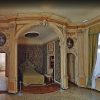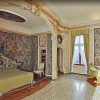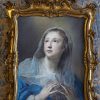In this room, an 18th-century bedchamber has been reconstructed, with its dressing rooms, wardrobe room and boudoir. The alcove comes from Palazzo Carminati at San Stae, and dates from the second half of the 18th century. The bed is enclosed in carved wooden framework painted ivory white. The wooden headboard is painted in tempera with in the centre a Holy family with Saint Anne and young St. John.
Above the bed is a pastel Madonna by Rosalba Carriera, datable to the second half of the 1720s.
Outside the alcove the furnishings consist of a walnut, inlaid chest with lid (bureau trumeau), probably of Lombard origin, and a green lacquered cradle with polychrome flowers. The walls are covered in 18th-century wallpaper decorated with small rural landscapes and ruins, over which figures have been moulded then painted.
On the right of the bed, a display case contains a toiletry set formerly belonging to the Pisani Moretta family. The set was made in 1752 for Cattaruzza Grimani on the occasion of her marriage to Pietro Vettor Pisani. The twinned crests of the two families appear on the lid of the coffer. Consisting of 58 pieces in gilded silver and green onyx, it is the work of a silversmith from Augsburg. All a lady could need is included: a large table mirror and a shell-shaped repousseé washbowl, a jewellery case, a powder bellows, candle holders and bottles for fragrances and perfumes, and even writing tools and cutlery.
Go through the door to the left of the alcove into the boudoir which was transferred here from palazzo Calbo Crotta. The walls still have the original 18th-century stucco work, while the paintings are by Costantini Cedini.


